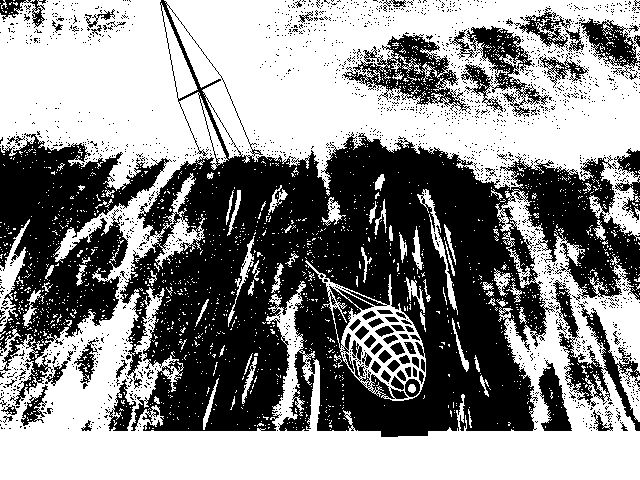D/M-17
Monohull, Cutter
41' x 8 Tons, Modified Fin Keel
36" Dia. Galerider Drogue
Force 11 Conditions
File D/M-17, obtained from Michael & Doreen Ferguson, Auckland, NZ - Vessel name St. Leger, hailing port Vancouver, monohull, G.R.P. cutter, LOA 41' x 8 Tons - Modified fin keel - Drogue: 36" Diameter Galerider on 250' x 3/4" polypropylene three strand rode, with 5/8" stainless steel swivel - Deployed in the Queen's Birthday Storm in deep water about 400 miles south of Fiji with winds of 60 knots and seas of 40 ft. and greater - Speed was reduced to about 3.5 to 4 knots during 60 hours of deployment.
St. Leger was in the same June 1994 "Queen's Birthday Storm" that claimed three lives and numerous yachts. Her Canadian owners, Michael and Doreen Ferguson, sent the following report to Skip Raymond of Hathaway, Reiser and Raymond, who then forwarded it to Victor Shane for inclusion in the database. Transcript:
We launched St. Leger in 1 May 1982. She is a 41 ft. G.R.P. cutter with modified fin keel and fully unbalanced rudder, using a "Sayes Rig" self-steering vane. We moved aboard St. Leger the day before the launching and have lived aboard since 1982. We retired in 1991, Mike was a Sargent with the Royal Canadian Mounted Police - the NCO I/C of Marine Services with commercial maritime qualifications. After a hair raising experience in severe weather in Queen Charlotte Strait in 1989, we purchased a Galerider drogue directly from Hathaway, Reiser and Raymond after seeing an advertisement in a yachting magazine.
In May of 1991 we left our home port of Vancouver, Canada, and headed for Alaska. Thus began our life as full time cruisers. In April 1993 we crossed the Pacific from Mexico, arriving in New Zealand in November of that year.
In June 1994 we departed Tauranga, New Zealand, bound for Fiji, with only Michael and I aboard. At 1600 hrs on our second day out and approximately 75 miles from the North Cape of New Zealand, we first heard of a low pressure system situated over Vanuatu, predicted to track southeast into our intended path. The weather forecast in our area predicted southeast winds 35-40 knots, not particularly severe, so we decided to continue on our course under reduced sail. Later, under bare poles and in deteriorating conditions, we ran before it in very steep, short seas, and the wind sustained at 50 knots, with higher gusts.
At about midnight on day 2 of the storm we decided to deploy the Galerider as our boat speed was now 11-12 knots in precipitous seas. We deployed the Galerider using a single line off the starboard quarter, approximately 250 feet of 3/4 inch three strand polypropylene line. We selected polyprop three strand because of its floating ability. Our plan was to slow St. Leger down, whilst still maintaining steerage using the "Sayes Rig" vane, due to shorthanded crew. Immediately upon deployment our boat speed was reduced to 3.5 to 4 knots and we felt much more comfortable.
The wind vane continued to steer beautifully, but as St. Leger slowed down in the troughs of the huge seas the tow line and Galerider tried to catch up to us, leaving a loose coil of 12 to 15 feet of tow line floating in close proximity to the vane's trim-tab steering paddle. Fearing that the slack line might tangle in the trim-tab and surely tear it off, Mike began bringing in the slack each time we were in a trough, using a primary cockpit winch, until the Galerider was approximately 80-90 feet behind the boat. The drogue was in the same wave as St. Leger, but on the other side of the crest [on the back side]. We observed the Galerider for hours! A small "half-moon" section of the drogue was visible at times, and we noted the three strand polypropylene tow line did not unwind, nor did the Galerider oscillate or rotate. And best of all, this enabled the wind vane to steer the whole time.
We towed the Galerider without incident for 60 hours, with winds at 60+ knots (our "Swoffer" wind gauge was pegged at its limit). At approximately 0800 hrs on day 5 the wind had dropped to 18-20 knots. The low pressure system was east of the Kermadec Islands and moving away from us. The seas were still high, but we readily retrieved the Galerider, which was in almost new condition with no damage or excessive wear after a tough workout!
We should also mention that the New Zealand Air Force Orion aircraft searching the area [for other vessels in distress] made a low pass over us and we advised them by radio that we were OK and not in need of their assistance. Our sails were set and we spent the next week hard on the wind in light northerly winds with very lumpy, confused seas. We arrived safely in Suva, Fiji, where we exchanged tales of the "Queen's Birthday Storm" that claimed three lives and seven cruising yachts. Everyone involved was interested in what "worked" and what didn't.
Love the Drag Device Database? Help us to keep it free for all mariners by making a tiny donation to cover our server and maintenance costs. Thank You!
